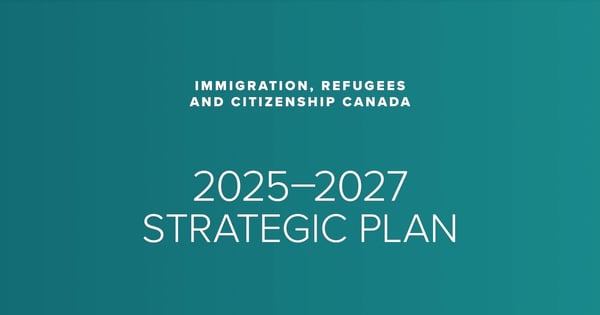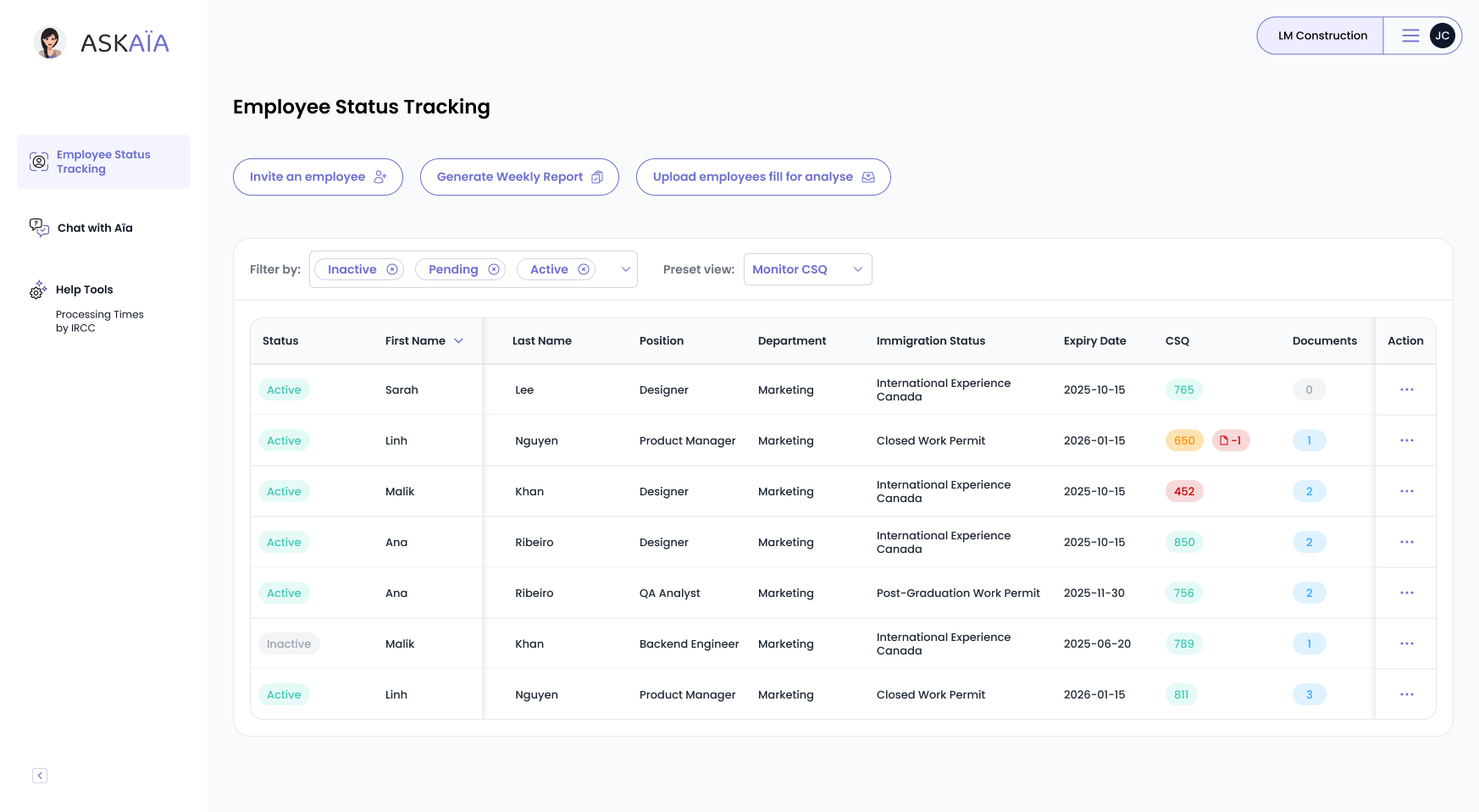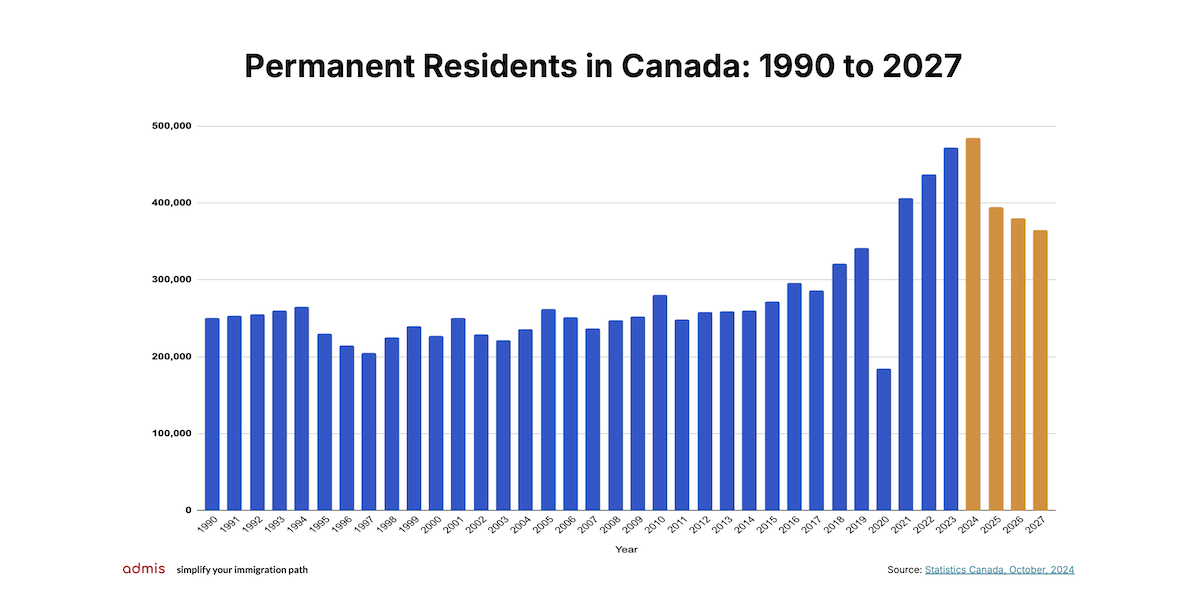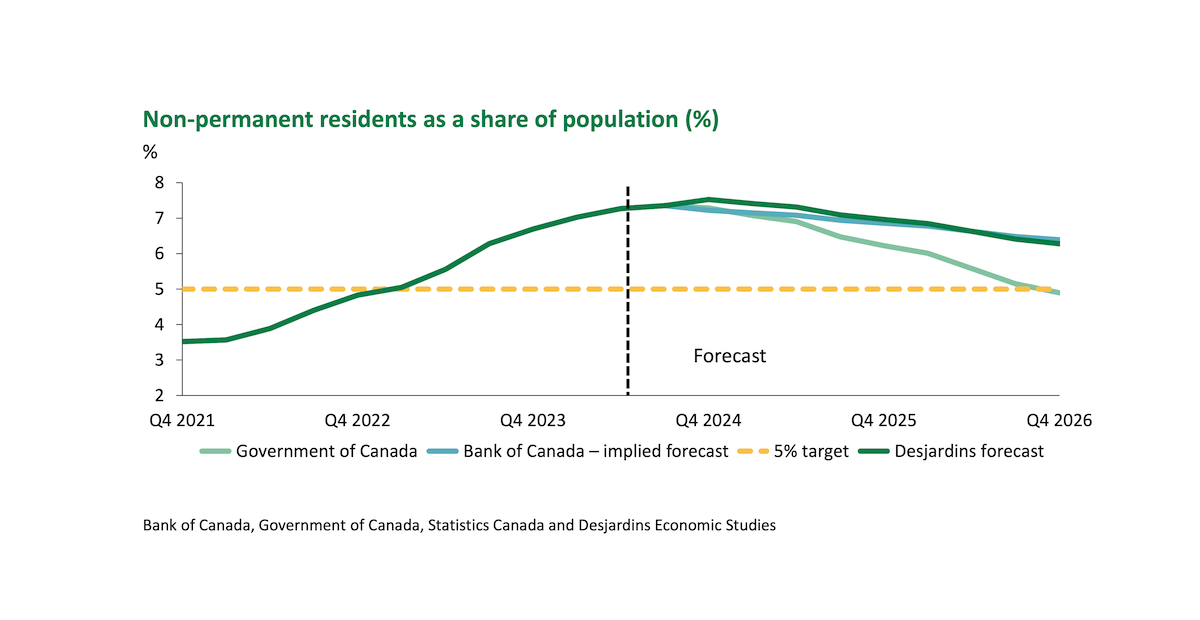Canada Immigration 2025-2027: How These 5 Policy Changes Affect You

On January 28, 2025, Canada announced its 2025-2027 Immigration Plan, introducing major updates to temporary visas, PR pathways, refugee resettlement, and fraud prevention. These changes aim to create a more balanced and efficient immigration system.
This guide explains each of the plan’s five key objectives announced yesterday, the government’s initiatives, and how they will impact you as an immigrant. From stricter visa rules to new regional opportunities, learn how to navigate the changes and succeed in Canada’s evolving system.
- Fewer Temporary Visas, More PR Opportunities
- Simplifying Applications and Reducing Delays
- Responding to Humanitarian Crises with Agility
- Stronger Fraud Prevention and Enhanced Transparency
- More Opportunities for Francophones and Skilled Workers
- How to Adapt to Canada’s 2025-2027 Immigration Plan

1. Fewer Temporary Visas, More PR Opportunities
Canada’s 2025-2027 Immigration Plan is reshaping immigration priorities by reducing reliance on temporary visas and expanding permanent residency (PR) pathways. This shift aligns with recent updates to Express Entry, which is increasing admissions to 124,590 spots in 2025, prioritizing skilled workers in healthcare, trades, and tech while removing job offer points from the CRS system.
Government’s Objective: Managed and Coordinated Migration
The government’s primary goal is to rebalance the immigration system by prioritizing permanent residency (PR) pathways over temporary visas. By capping temporary residents at 5% of the population by 2026, the policy seeks to alleviate pressure on infrastructure while directing immigrants to regions where labor shortages persist.
Key Initiatives
1. Fewer Study Permits and Temporary Work Visas
- Strict caps on international student permits to limit inflows.
- Tighter restrictions on temporary work permits to prioritize sectors with verified labor shortages.
2. More PR Opportunities in Less Populated Areas
- Increased PR allocations through regional programs, including Provincial Nominee Program (PNP) and Rural and Northern Immigration Pilot (RNIP)
- Stronger employer and provincial partnerships to support immigrant integration outside major urban centers.
KPIs to Track Success
- Temporary residents reduced to 5% of the total population by 2026.
- Increased PR approvals through regional immigration programs.
- 8.5% francophone immigration target by 2025, increasing to 10% by 2027.
What’s Changing?
1. Fewer Temporary Visas, Stricter Approvals
- Study permit and work visa approvals will be significantly lower, making admission more competitive.
- Applicants will need to meet stricter requirements, particularly in proving financial capacity and program eligibility.
2. Regional PR Will Be the Fastest Pathway
- Immigrants who choose smaller cities and rural areas will have an easier time obtaining PR.
- More incentives for employers in less populated areas to hire and sponsor foreign workers.
3. Temporary Residents Must Secure PR Faster
- Work permit renewals may be harder to obtain, pushing temporary workers to apply for PR sooner.
- International students will need to plan early for PR pathways after graduation.
What It Means for Immigrants
For International Students: More Competition, Stricter Rules
- Limited study permits mean higher admission standards—check provincial quotas before applying.
- Stronger financial requirements will be enforced to ensure students can afford living expenses.
- Post-Graduation Work Permit (PGWP) eligibility will be crucial for PR.
For Temporary Workers: PR is No Longer Optional—It’s Necessary
- Fewer work permit extensions mean securing PR early is essential.
- Express Entry and PNP applications should be started as soon as eligibility is met.
For New PR Applicants: Regional Immigration is the Best Bet
- If you are willing to settle in smaller cities, your PR chances will be much higher.
- Francophone immigrants and workers in priority industries will have additional PR incentives.
Want to check your eligibility for PR? Aïa’s assessment will analyze your profile and suggest the best immigration pathways under the new rules.
2. Simplifying Applications and Reducing Delays
Under Canada’s 2025-2027 Immigration Plan, the government is modernizing its immigration system with a Digital-First strategy to improve efficiency and reduce delays. This shift comes at a critical time, as recent job cuts at IRCC have contributed to growing application backlogs. With fewer immigration officers processing cases, Canada is turning to automation and centralized digital platforms to streamline visa and PR applications.
Government’s Objective: Modernized and Simplified Immigration Programs
The government’s goal is to digitize the immigration system to handle higher volumes of applications while minimizing bottlenecks. This strategy also focuses on providing faster, more predictable processing times for applicants while reducing administrative complexities for both immigrants and the government.
Key Initiatives
1. A Unified Online Immigration Platform
- Canada is creating a centralized digital portal where applicants can submit, track, and manage all immigration-related applications, from visas to permanent residency and citizenship.
- This platform will integrate application steps, eliminating the need to interact with multiple systems.
2. Automating Routine Decisions
- Routine applications, such as renewals or straightforward visa requests, will be processed through automation, significantly reducing wait times.
- Applicants will receive real-time updates on the status of their cases, improving transparency and predictability.
3. Eliminating Redundant Paperwork
- Simpler document requirements will reduce the administrative burden on applicants.
- Less in-person interaction will save time for immigrants while improving government efficiency.
KPIs to Track Success
- 90% of applications processed digitally by 2026.
- Significant reduction in average processing times for visas and PR applications.
- Improved client satisfaction rates, measured through annual surveys.
What’s Changing?
1. Fully Digital Application Processes
- Immigration processes will be completely digitized, making it easier to submit and track applications online.
- Automation will take over routine decisions, reducing manual errors and delays.
2. Faster Approvals for Eligible Applicants
- Simple, well-documented cases will benefit from faster processing times, but applicants must ensure that all documents are error-free to avoid rejections.
3. Reduced In-Person Requirements
- Fewer in-person interactions mean applicants will spend less time on administrative steps. This shift reduces costs for immigrants and processing teams alike.
What It Means for Immigrants
For New Visa Applicants: More Efficiency, Stricter Accuracy
- Applications will move faster, but errors in submitted documents could result in automatic rejections due to automation.
- Real-time status tracking will let you monitor your progress without having to contact immigration offices directly.
For Current Applicants: Shorter Wait Times
- If you’ve already applied for a visa, permit, or PR, expect faster processing once the platform is fully implemented.
- Cases that are straightforward and complete will be prioritized for quicker approvals.
For Future Applicants: Learn the New System Early
- Immigration procedures will change significantly. Understanding how to use the new online system will be critical for ensuring smooth applications.
- With fewer opportunities for in-person corrections, accurate submissions will matter more than ever.
3. Responding to Humanitarian Crises with Agility
As part of its 2025-2027 Immigration Plan, Canada is strengthening its humanitarian immigration system to ensure faster and more efficient protection for refugees and asylum seekers. The government is introducing a Crisis Response Framework to better manage surges in migration caused by conflicts, natural disasters, and humanitarian crises.
Government’s Objective: Agile and Fair Humanitarian Response
The primary goal is to ensure that Canada’s immigration system can adapt quickly to humanitarian crises while maintaining fairness and efficiency. This includes improving processing times for asylum claims, ensuring access to protection for vulnerable groups, and fostering successful refugee resettlement in regions that can best support their needs.
Key Initiatives
1. Crisis Response Framework
- Canada will implement a specialized framework to quickly respond to migration emergencies, such as conflicts or natural disasters.
- Resources will be allocated to fast-track the intake and processing of refugees during crises.
2. Streamlined Asylum Processing
- Shorter processing times for asylum seekers to reduce uncertainty and provide faster access to protection.
- Enhanced collaboration with the Canada Border Services Agency (CBSA) and the Immigration and Refugee Board (IRB) to resolve cases efficiently.
3. Improved Refugee Resettlement Support
- Provinces and territories will receive increased funding to expand housing and integration services for refugees.
- Focus on voluntary relocation programs to place refugees in communities equipped to meet their needs.
KPIs to Track Success
- Operational Crisis Response Framework implemented by 2025.
- Reduction in asylum claim processing times, with specific benchmarks for urgent cases.
- Increased rate of successful refugee resettlement, ensuring long-term integration into Canadian communities.
What’s Changing?
1. Faster Asylum Processing Times
- Refugees and asylum seekers will face shorter waiting periods for decisions on their claims, reducing uncertainty and stress.
2. Greater Federal-Provincial Collaboration
- Improved coordination between federal and provincial governments will ensure better access to housing, healthcare, and jobs for new arrivals.
3. Focus on Crisis Management
- Resources will be reallocated to respond to unexpected humanitarian crises, ensuring Canada can quickly adapt to global emergencies.
What It Means for Immigrants
For Refugees and Asylum Seekers: Faster Protection and Support
- Shorter delays mean vulnerable individuals can access safety and resources more quickly.
- Improved resettlement programs will provide better housing, language training, and community integration.
For Private Sponsors: Simplified Processes, Quicker Results
- Faster asylum claim resolutions will make it easier for sponsors to support refugees through more predictable timelines.
- Increased provincial funding will ensure better collaboration with sponsor groups.
For Communities Hosting Refugees: Stronger Local Support
- Expanded funding will help communities provide housing, education, and healthcare to newly arrived refugees.
- Voluntary relocation initiatives will connect refugees to areas best suited to support their integration.
4. Stronger Fraud Prevention and Enhanced Transparency
As part of its 2025-2027 Immigration Plan, Canada is reinforcing the integrity of its immigration system by tightening fraud prevention measures, enhancing transparency, and safeguarding legitimate applicants. Immigration fraud remains a major issue, with over 153 charges filed against fraudulent consultants since 2019 and 700 students scammed in 2023 alone. To combat this, the government is implementing stricter verification for study permits, work visas, and PR applications, introducing digital fraud detection tools, and ensuring immigration officers are better equipped to identify and prevent scams.
Government’s Objective: Strengthening Program Integrity
The government aims to reduce fraud and abuse in immigration programs, ensuring fairness for genuine applicants while protecting the system from misuse. This includes improving the verification of applications, enhancing data-driven decision-making, and addressing systemic biases to promote equity in immigration decisions.
Key Initiatives
1. Verification of School Acceptance Letters
- A digital verification system will authenticate letters of acceptance from Canadian institutions to prevent fraudulent study permit applications.
- Schools not meeting government standards may face stricter oversight or removal from approved institution lists.
2. Enhanced Fraud Detection Tools
- Advanced digital tools and algorithms will be deployed to identify fake documents, fraudulent job offers, and misleading applications.
- Immigration officers will receive enhanced training to better detect and investigate fraud cases.
3. Risk Management Framework
- A comprehensive risk assessment strategy will analyze global trends and anticipate fraud patterns.
- This framework will also ensure that legitimate applicants are not penalized due to overly broad enforcement measures.
KPIs to Track Success
- Reduction in fraud cases in study permits, work visas, and PR applications.
- Implementation of the digital letter verification system by 2025.
- Annual reports on systemic bias and progress toward more equitable decision-making.
What’s Changing?
1. Stricter Controls on Study and Work Applications
- Applicants for study permits must ensure their chosen institutions are recognized and meet IRCC standards.
- Employers sponsoring work permits will face tighter scrutiny to ensure job offers are legitimate.
2. Advanced Fraud Detection Measures
- New digital tools will flag inconsistencies in applications, reducing the likelihood of fraudulent cases slipping through.
- Applicants may face additional checks and requirements, particularly in high-risk application streams.
3. Increased Transparency in Decision-Making
- Immigration officers will use data-driven systems to ensure unbiased and fair decisions.
- Applicants will have better access to explanations for visa refusals and clear pathways for appeal.
What It Means for Immigrants
For International Students: Tighter Rules, Safer Processes
- Students must verify that their acceptance letters come from IRCC-approved institutions to avoid rejections.
- The system will protect genuine applicants by reducing fraudulent entries, ensuring a level playing field.
For Temporary Workers: Verify Your Employer’s Legitimacy
- Work permit applicants will need to ensure their employers are verified and meet all compliance requirements.
- Fraudulent job offers will be flagged early, reducing the risk of visa denials.
For PR Applicants: Greater Accountability and Fairness
- Data-driven decision-making will ensure more consistent and equitable outcomes, especially for applicants from underrepresented regions or industries.
- Clearer guidelines on documentation will help applicants avoid errors and confusion.
Worried about stricter visa rules or fraud prevention checks? Aïa can verify if your documents and job offers meet Canada’s new standards.
5. More Opportunities for Francophones and Skilled Workers
Through its 2025-2027 Immigration Plan, Canada is advancing a more inclusive and sustainable immigration system by expanding opportunities for Francophones and skilled workers in high-demand sectors. This aligns with recent updates reserving over 40% of PR spots in 2025 for temporary residents, including international students and workers already in Canada. With Quebec maintaining its own immigration system and setting lower targets, Francophone immigrants seeking PR are increasingly encouraged to settle in other provinces offering strong economic opportunities and tailored immigration programs.
Government’s Objective: Sustainable and Inclusive Immigration Programs
The government aims to increase immigration diversity and equity while addressing critical labor shortages in key sectors such as healthcare, tech, and skilled trades. By encouraging Francophone immigration outside Québec and supporting underrepresented groups, Canada intends to build a system that reflects its multicultural identity and workforce needs.
Key Initiatives
1. Enhanced Francophone Immigration Pathways
- Special Francophone streams within the Express Entry and Provincial Nominee Programs (PNPs) will prioritize French-speaking candidates willing to settle outside Québec.
- Increased marketing and outreach efforts in Francophone countries to attract skilled workers.
2. Targeted PR Pathways for In-Demand Workers
- Additional points in Express Entry for workers in priority sectors like healthcare, trades, and tech.
- New regional and employer-driven programs to streamline immigration for essential workers in smaller communities.
3. Equity and Diversity Initiatives
- Policies to eliminate systemic barriers in immigration decision-making, ensuring equitable access for all applicants.
- Enhanced training for immigration officers to promote unbiased and inclusive assessments.
KPIs to Track Success
- Francophone immigration outside Québec increases to 10% of total admissions by 2027.
- PR approvals for healthcare, tech, and trades workers grow annually, meeting labor market targets.
- Annual equity reports to measure and address biases in the immigration system.
What’s Changing?
1. More Opportunities for Francophones Outside Québec
- Priority programs for Francophones will make it easier to secure PR, particularly for those choosing to settle in smaller cities and rural areas.
- Increased funding for programs that support language integration and settlement services for French-speaking immigrants.
2. Stronger Focus on Essential Workers
- Skilled workers in healthcare, construction, and technology will have faster access to PR pathways through regional and national programs.
- Employers in smaller provinces will have greater incentives to sponsor foreign workers in these fields.
3. A More Inclusive Immigration Process
- New equity-focused policies will ensure fairer evaluations of applications, addressing concerns about systemic discrimination.
- Enhanced access to immigration pathways for underrepresented groups such as women in trades and workers from lower-income countries.
What It Means for Immigrants
For Francophone Applicants: Easier PR Access Outside Québec
- Francophones willing to live in regions outside Québec will benefit from priority immigration programs.
- Language-specific support will make it easier to integrate into English-speaking communities while maintaining French identity.
For Skilled Workers: PR Fast-Tracked in Key Sectors
- Healthcare workers, tech professionals, and tradespeople will find it easier to immigrate as the demand for their skills grows.
- Regional and employer-driven pathways will provide faster, more reliable immigration routes for high-demand workers.
For All Applicants: Fairer and More Equitable Processes
- New policies will reduce barriers for underrepresented groups, ensuring everyone has an equal chance to succeed.
- Applicants will benefit from greater transparency and accountability in decision-making.
Are you eligible for Canada’s Francophone or high-demand worker streams? Use Aïa’s free assessment to find the best immigration path for you.![]()
6. How to Adapt to Canada’s 2025-2027 Immigration Plan
With Canada’s 2025-2027 Immigration Plan now in effect, immigrants must adapt to shifting policies. In 2025, tighter visa rules, evolving PR pathways, and regional settlement priorities will shape opportunities. Understanding these changes and planning strategically will be key to navigating Canada’s new immigration landscape.
1. Understand the New Priorities
The focus is shifting toward long-term settlement through permanent residency (PR) and regional immigration programs. Temporary visas will become harder to obtain, while digital systems and regional pathways will make the immigration process more structured and transparent.
- Research Provincial Nominee Programs (PNPs) and regional initiatives like the RNIP.
- Confirm your school’s DLI status if you’re an international student.
- Explore Francophone pathways for immigration outside Québec.
2. Strengthen Your Application Documents
Accurate and complete documentation is critical, especially with the automated systems in the new immigration framework. Mistakes could lead to automatic rejections, so applicants must ensure every detail is correct and all required documents are included.
- Verify that your letters of acceptance or job offers meet IRCC standards.
- Scan all documents clearly in the required formats (e.g., PDF).
- Use checklists to ensure you’ve included all required files.
3. Plan Your PR Pathway Early
Securing permanent residency (PR) is becoming more important as temporary permits face stricter requirements and shorter renewal opportunities. Immigrants should strategize early to transition from temporary to permanent residency through Express Entry or regional programs.
- Use the Express Entry system to calculate your eligibility and improve your score.
- Choose programs with PGWP eligibility if you’re an international student.
- Focus on priority sectors like healthcare, tech, and trades.
4. Leverage Digital Tools and Automation
The immigration process will be entirely digitized, offering faster submissions and real-time updates. Applicants must become comfortable using Canada’s new online portal and ensure their documents meet the system’s requirements to avoid delays or rejections.
- Learn to navigate the centralized immigration portal for tracking and submissions.
- Submit complete, error-free documents to avoid flags in the automated process.
- Use online tools to monitor your application status in real time.
5. Monitor Regional Opportunities
Canada’s immigration strategy emphasizes settling immigrants in smaller communities where labor needs are greatest. Francophone immigrants and skilled workers willing to move to less populated areas will benefit from enhanced PR opportunities and tailored programs.
- Check regional economic needs and align your skills with in-demand roles.
- Explore Francophone streams within programs like PNP and Express Entry.
- Look for employer sponsorships in smaller provinces.
6. Stay Updated on Policy Changes
Immigration policies are evolving, and staying informed is essential to adapting effectively. Regular updates from IRCC and using digital tools can help you keep track of new deadlines, requirements, and opportunities as they arise.
- Follow official IRCC updates on policy changes and deadlines.
- Use tools like Aïa to receive alerts about key changes affecting your application.
- Join immigrant support groups to learn from others navigating the process.
7. Prepare Financially for Immigration
Canada’s new plan introduces stricter financial requirements for some immigration streams. Applicants should be prepared to show sufficient funds for tuition, living costs, or settlement needs. Budgeting for fees and other costs is crucial for success.
- Ensure you meet proof of funds requirements for your application.
- Create a budget that includes application fees, travel, and legal costs.
- Explore funding options like scholarships, employer sponsorships, or government programs.
Conclusion
Canada’s 2025-2027 Immigration Plan introduces major policy shifts, making it crucial for immigrants to understand how these changes impact their pathways. With fewer temporary visas, more regional PR opportunities, and fully digital applications, applicants must be proactive in adapting their strategies to secure their immigration status.
If you're unsure about your best options, Aïa’s free assessment provides personalized insights based on your profile. Whether you're exploring PR pathways, checking visa eligibility, or navigating new requirements, Aïa helps you make informed decisions. Start your free assessment today and take control of your immigration journey.![]()

Let’s get your demo started
Book a demo
You May Also Like
These Related Stories

Canada Expands Francophone Immigration: Key Opportunities in 2025
Canada’s immigration system has expanded significantly, but recent job cuts at IRCC pose new challenges for applicants. This article explores workforc …

New Canada's 2024-2027 Immigration Plan: Impact on Permanent Residence
The government announced its new immigration plan for the period 2024 to 2027 this week, sparking many questions for immigrants who need to adapt thei …

Is Canada’s Immigration Slowdown in 2025 as Sharp as Planned?
Canada is adjusting its immigration policies in 2025, but is the slowdown as drastic as expected? A new Desjardins report suggests otherwise. In this …